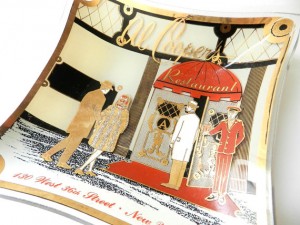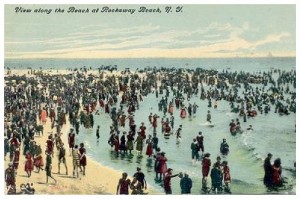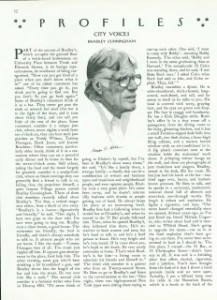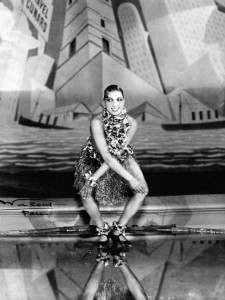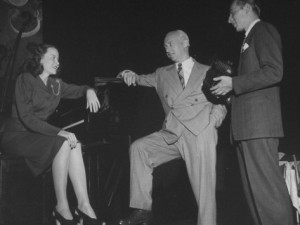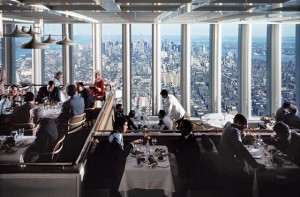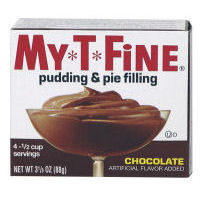During the 50’s and 60’s, one of HG’s favorite New York restaurants was Al Cooper’s located in the Garment Center at 130 W. 36th Street. It was a steak house and its sirloins were on a par with those served at the great Christ Cella, the place which started “Steak Row” — that proliferation of bovine-centric eateries in the East 40’s. While Christ Cella catered to admen, P.R. professionals and sports figures, Al Cooper’s (because of location) was the favorite of fashion big shots. That’s where Christian Dior dined when he was in New York to meet with his U.S. affiliates. The majority of Al Cooper’s customers were Jewish so the restaurant had a number of down home Jewish treats on its menu: superior chopped liver and gefilte fish. During the spring and summer there was icy borscht plus fruit and vegetable dishes smothered in rich sour cream. HG usually ordered a Cooper specialty: A super thick cut of very tender boiled tongue served with superior creamed spinach and English mustard. A delicious dish that HG has never encountered in any other eatery.
Al Cooper’s: Fashion Favorite
August 11th, 2013 § 0 comments § permalink
Reviving a Depression Era Treat
August 2nd, 2013 § 0 comments § permalink
When HG was growing up in The Bronx during the Great Depression, nothing was ever wasted. All left over vegetables and their peelings, etc. went into an improvised soup that HG’s mom enriched with meat and chicken scraps and their flavorful bones. Left over fish was chopped with onions and celery (plus Hellman’s Mayonnaise) to become fish salad. Stale challah (egg bread) was used for very good French toast. Stale rye and pumpernickel (White bread of the Wonder and Silvercup variety had no place in Mom’s kitchen) got the roller pin treatment to make breadcrumbs (no food processors in those days). Fruit past its prime was mixed with dried prunes and cinnamon. Then stewed into an acceptable dessert fruit compote. Little HG looked forward to Mom’s treatment of left over boiled (or mashed) potatoes. They were mixed with fried onion and beaten eggs, formed into pancakes, fried to a crisp and devoured (happily) with sour cream and black pepper. Last night, BSK made smashed potatoes — boiled Prince Edward Island potatoes chopped roughly with scallions and hot chicken broth. On this rainy afternoon, HG found the left overs in the fridge. Mixed them with a beaten egg. Formed them into little patties and fried them in corn oil. Dusted them with sea salt and smoked pepper. Greek yogurt accompanied. HG was a kid again.
Partying on Fire Island
July 28th, 2013 § 0 comments § permalink
The Davis Park/Ocean Ridge section of eastern Fire Island (the long barrier beach south of Long Island,N.Y.) was battered by Hurricane Sandy but survives. Many years ago, HG/BSK had a house there perched atop a sand dune with spectacular views of the Atlantic Ocean on one side and the Great South Bay on the other. The duo plus daughter Lesley and SJ spent every weekend there from late March to early October (BSK and kids were there full time for July and August while HG steamed in New York). Those days were brought back to HG/BSK last night when they dove into some big bowls of BSK’s special linguini in white clam sauce. Weekends on Fire Island featured great food and drink, much appreciated by appetites sharpened by the sun and salt air. Here are some of the memorable dishes served up by HG/BSK’s Fire Island friends and neighbors: Gravlax with a pungent mustard and dill dressing (made by the late Willa Z.). Perfect sirloin steaks grilled in the oven by the late John A. who hated the barbecue with its unreliable levels of heat. The late Glenn F.’s Swedish smorgasbord with a dozen varieties of herring washed down with Aakavit and beer. The 20-dish rijstaffel prepared in a tiny kitchen by two guys whose names HG can’t recall. The Normandy-style steamed mussels prepared by a woman (name also forgotten) who had previously summered in France. The roast lamb that cooked all day over a wood and charcoal fire (supervised by a fellow with an Armenian background). Omelettes and Bloody Marys for brunch at a pretty blonde’s house. Spaghetti Carbonara at (the late) Veronika H.’s. The late Hobby Miller’s community fish fry with corn meal coated filets sizzling in hot oil. The best-of-all fish dishes prepared on the barbecue by the late Catalan sculptor Joan Junyer (friend and compatriot of Picasso) . He would toss whole fish on the barbecue for brief cooking. Then off the grill for a quick de-boning. The firm, juicy and slightly smoky filets got a pour of olive oil and a squeeze of lemon. Magic. (Sorry to describe so many people with the adjective “late” but time and fate are inexorable.) HG and BSK hosted many a great cocktail party on their rear deck with the sun setting over Long Island. With clams HG and BSK (sometimes with the help of SJ and Daughter Lesley) had just plucked from the Great South Bay, HG would prepare clams casino to nosh on while those who stayed for dinner had, naturally, BSK’s signature clams and linguini.
But, one of the most memorable Fire Island meals HG can recall took place in the bleak years before HG met BSK. A large group of Fire Islanders — very much under the influence of prodigious quantities of martinis and marijuana — mused that a meal of great Chinese food would really hit the spot. Good fortune. One of their number was a wealthy, young Chinese guy (tungsten, HG believes, was the source of his fortune). He called his office in New York City and gave some rapid orders in Cantonese. In 90 minutes, a seaplane landed in the Bay. Two Chinese gentlemen emerged carrying huge, metal tureens of duck, lobster, shrimp, fish, pork, beef, bean curd, noodles, vegetables, and more — all from Chinatown’s best restaurant. In moments, the hungry crowd was feasting on their dreams. HG realized then that there are some tangible benefits attached to wealth.
Rockaway Revels Now and Then
July 14th, 2013 § 0 comments § permalink
SJ, in his role as the head of Deadly Dragon Sound System (esteemed selectors of Jamaican music) entertained a crowd last week gathered at Caracas Arepa Bar located at Seaside Avenue (103rd Street) and the Rockaway Beach Boardwalk; it was once the home of Sligo Tavern and other raucous Irish entertainment venues. SJ reported that while many repairs are still needed, Rockaway was full of life and strongly recovering after the Hurricane Sandy devastation. Brought back memories of HG’s teenage days at that proletarian playground. At various times during the summer, HG’s boy and girl pals would have a night time beach party on the Rockaway sands. Communal blankets were brought to the beach. If a couple who were “going together” brought their own blanket it was a tip-off that they would wander away from the group for some serious intimacy. A bonfire was built and hot dogs and marshmallows were toasted in the flames. Much beer was drunk. In those days underage youngsters could easily purchase beer. One night, HG’s buddy, Larry M., brought a bottle of vodka. Mixed it with grapefruit juice, it proved potent. Larry M. had an interesting career. Unlike most of us, Larry did not go to college but pursued a profitable career as a marijuana dealer. After some years, he abandoned illegal activity and became a very wealthy shopping center developer and Democratic party fund raiser. An ironic note: His close friend, Willie, became a New York City policeman and was shot to death in a West Side hotel during a drug arrest.
No to Nostalgia
July 12th, 2013 § 2 comments § permalink
HG/BSK watched a World War Two propaganda movie (set in an improbable Poland) with perky Ida Lupino and stiff Paul Henreid. Excruciating. Terrible acting. Moronic plot. Next night watched Detective Story, the film adaptation of Sidney Kingsley’s Broadway hit play of the same name. When it was released the film was lauded for its realism. Hmmm…Kirk Douglas and Eleanor Parker are the stars and the deliver stagey, scenery-chewing performances. William Bendix, in a supporting role, is the only actor in the film who seems to have a grasp on naturalist performing. HG/BSK agreed: Today’s movie actors are infinitely better than yesterday’s. Yes, there were interesting personalities in the past (Cagney, Bogart, Gable, etc.) but few actors with the abilities of today’s stars. No one with the range of Meryl Streep, Philip Seymour Hoffman and many others. Now, how does this relate to HG’s main focus, food? Well, HG may get nostalgic, and rightfully so, about long closed classic New York restaurants like Gage & Tollner, Luchow’s and Christ Cella; also, HG may get a bit wistful recalling the hearty blue collar eats of a New York that simply does not exist anymore. But, the reality is that today’s restaurant cooking is much better than that of the past. There is more emphasis on fresh, local ingredients and less use of butter, cream and heavy sauces. Greater use of a wide range of international ingredients. HG/BSK thought about this while enjoying imaginative dishes at 3 Petit Bouchons, a charming Montreal bistro. Grilled octopus with grilled potatoes. Cod with fiddlehead ferns and asparagus. Duck confit on Waldorf salad. Unusual sauces. A light touch. Dishes that would never have appeared on a menu 40 years ago. Also, because of changes in immigration patterns and disruptions in Asia and the Middle East, today’s restaurant diner (especially in New York) can taste extraordinary (and often very inexpensive) dishes from many parts of China as well as Thailand, Burma, Malaysia, India, etc. And, excellent Syrian, Lebanese, Turkish food abounds. The exposure to these diverse cuisines and the availability of the ingredients to prepare them has been one of the great boons to our restaurant culture — expanding palates and influencing chefs in the most positive way. To give you an idea of how insular cuisine was (even in New York) the big town in the 1950’s had only one Mexican restaurant — Xochitl. And, that was quite ordinary and Americanized.
University Place Free Association Part III: Bradley Cunningham
June 10th, 2013 § 2 comments § permalink
Bradley’s, the intimate bar, restaurant and music venue on University Place, encouraged many HG and BSK smiles. It was small — 15 tables and 20 bar stools. The food — steaks and hamburgers — was honest and good; the music, however, was great. On a platform was a baby grand piano (contributed to Bradley Cunningham, the proprietor, by the great saxaphonist, Paul Desmond). The world’s greatest jazz pianists (sometimes accompanied by a bass) played there. Tommy Flanagan, Teddy Wilson, Jimmy Rowles and Kenny Barron were among them. Bradley made sure it was an orderly room where artistry could be appreciated and heard. (There was also some nice visual art in the room — three BSK acrylics were among the paintings over the bar). Bradley was a big, craggy- faced, ruggedly handsome guy (died of lung cancer in 1988). He was interesting. A fine amateur pianist and an appreciator of good writing and a true lover of New York. Served as a Marine in World War Two, learned Japanese and used that skill to talk Japanese soldiers out of indefensible bunkers and later interrogate them. He had witnessed much horror. He was in Nagasaki soon after its atomic bombing. Bradley and his friends, the great vocal and piano duo of Jackie Cain and Roy Kral (Jackie still performs occasionally. Roy died a few years ago) rented a Fire Island house near HG/BSK’s dune house and became dear friends of HG and BSK. HG encouraged Jackie and Roy to buy a house in Montclair, N.J., where HG lived. They did and HG and BSK would often drive into New York for an evening at Bradley’s or meet there late at night after theater or movies. Bradley married Wendy, the beautiful, long time waitress. HG and BSK joined Jackie and Roy at the wedding at a West Village church and had a celebratory meal at Leon Lianides’s Coach House House Restaurant on Waverley Place. Much joy. After Bradley’s death, Wendy kept his place alive until the final closing in 1996. Stanley Crouch wrote a lovely piece about Bradley’s in the New Yorker (Aug. 26, 1996). When Bradley was still alive, the jazz writer and critic, Whitney Baillet, did a full length profile of him in the New Yorker. You can access both pieces from the New Yorker archives. Do so.
University Place Free Association Part II: Ivan Black and Barry Gray VS. Walter Winchell and the Stork Club
June 9th, 2013 § 2 comments § permalink
In 1951 Ivan Black, the press agent for the Cafe Society clubs, became involved in a bitter battle with Walter Winchell, the all-powerful columnist and radio personality. Josephine Baker, the New York raised, African American dancer who had become one of the most famous entertainers in France, went to the Stork Club — at the time, one of New York’s top clubs and celebrity hangouts. Ms. Baker felt she received rude service because of her race and she made her displeasure known. A radio talk show guy, Barry Gray, took up Baker’s cause and criticized Sherman Billingsley, the Stork Club proprietor. Billingsley was a Winchell pal (WW had a nightly table in the Club’s super-exclusive Cub Room). The battle was on: Barry Gray and Ivan Black VS the Stork Club and Walter Winchell. WW accused Baker of fascist sympathies and communist ties. (Baker sued WW for defamation — but the timid State Department refused her a visa for some years so she was unable to take the suit to court). WW characterized Barry Gray and Ivan Black (who was also the press agent for the restaurant where Gray broadcast) as “commie sympathizers.” In WW’s columns, Gray was ” Borey Pink” and Black was “Ivan Pink.” Such was Winchell’s power that Gray was hounded out of New York. He relocated to Miami where he was very successful and later returned to New York as a popular (and politically conservative) radio gabber. Today, he is acknowledged as the “Father of Talk Radio.” Ivan, a gentle and scholarly Harvard graduate, had some business reverses but survived. The Ivan Black papers at the New York Public Library (some 55 boxes of press releases, clippings, photos and musical scores) are an invaluable historical source for the night club and jazz scene in New York (1937-1978).
Winchell? Television destroyed him. His TV show was a flop. Soon his radio broadcast and column disappeared. With chagrin, he watched his old rival, Ed Sullivan, become a TV icon. (Yes, WW did voice overs on “The Untouchables” TV show but that was just nostalgia shtick). WW died, quite forgotten, age 74. HG is ambivalent about WW. Winchell liked the prose HG contributed to his column and gave HG clients favorable mention. HG’s career as a press agent got a jump start when Winchell printed, in bold face, a prose poem HG authored. WW sent HG a note: “Keep it comin’, keed–WW.” And that’s what HG has done for many a year.
As for Abel “Strange Fruit” Meeropol who was mentioned in Part I of the University Place posts: He and his wife adopted the two orphaned young sons of atom spies Julius and Ethel Rosenberg. Both boys grew up to be college professors. Their childhood with the Meeropols was a happy one. Abel, they recall, was a master of comic improvisations and impersonations. He kept them laughing. After the torment that those boys went through, HG is certainly thankful for that.
University Place Free Association Part 1: Barney Josephson
June 8th, 2013 § 2 comments § permalink
HG recently did a post on the good and bad sides of Cedar Bar the legendary hangout of abstract expressionist artists and their hangers on. Its location was University Place in New York’s Greenwich Village neighborhood. A meandering torrent of HG memories ensued. Let’s start with an omelette and burger joint, Cookery, on the corner of 8th and University Place. Food was adequate but secondary. Its renown was based on live jazz. Mary Lou Williams and Alberta Hunter were two of the club’s star performers. Opened in the 50’s and had an almost 30-year run. The owner was a Village legend, the elegant and courtly Barney Josephson. A remarkable guy, Barney was a race relations pioneer. In 1940, he opened a night club — Cafe Society Downtown — in a basement on Sheridan Square. First totally racially integrated — performers and audience — night club in New York and perhaps in the United States. Even the great Harlem clubs of the 20’s — the Cotton Club, etc. — were “whites only.” Yes, a few African-American were seated, but in obscure, hidden locations. Barney changed all that. With the legendary John Hammond acting as talent scout, Barney booked great jazz artists like Billie Holliday and Sarah Vaughan and fledgling stars like Lena Horne. He is also credited for starting the vogue for folk music in Greenwich Village by presenting Josh White. It wasn’t all music. There were laughs. Zero Mostel was the Master of Ceremonies and Imogene Coca and Carol Channing performed there. The club’s press agent, Ivan Black (more on him later), gave Mostel his odd first name: “Because he came from nothing.” A Bronx school teacher, Abel Meeropol (more on him later), approached Barney with a song he had written, Strange Fruit, a passionate, wrenching protest against the lynching of African-Americans. Billie Holliday sang the song and it was a smash. Barney had special rules for the song. It would end her set and there would be no encore. The club would go silent and there would be no service when it was sung. No lights but a baby spot on Holliday’s face. HG was too young for Cafe Society Downtown but heard Billie sing it at the Onyx Club on W. 52nd Street. Same presentation. Devastating. With the success of Cafe Society Downtown, Barney opened Cafe Society Uptown on E. 58th. Both clubs flourished. Then, disaster. Barney’s brother, Leon, was the lawyer for both clubs. A radical leftist (Leon was briefly jailed in Denmark in 1935 for joining in an unsuccessful plot to kill Hitler), Leon was called before the House Un-American Activities Committee at the height of the Red scare. Tough and defiant, Leon refused to testify and was cited for contempt. The Hearst newspapers and their columnists (Westbrook Pegler, Dorothy Kilgallen and Walter Winchell), declared war on
Josephson and the two clubs. Performers were cowed by threats their careers would end if they performed at “commie” clubs. People who patronized the clubs feared reprisals. By 1948 the clubs were gone. Barney was quiet for a while but soon got back in action by founding the Cookery chain. At one point there were five but Barney closed the other four so he could concentrate on the University Place location. The University Place Cookery closed in 1984 after reuniting Jospehson with many of the performers he had introduced at the original Cafe Society. In 1988 he died at 86.
Views
June 2nd, 2013 § 0 comments § permalink
HG and BSK have been very fortunate in life to have dined looking out at a variety of spectacular views. Of course, nothing will ever match the sweeping New York vistas from tragic, doomed Windows on the World Restaurant on the 105th and 106th floors of the World Trade Center. HG dined there often, managed news conferences and business meetings in its convivial setting. (One of HG’s business colleagues was among four people who left the restaurant and elevatored to safety just minutes before the terrorist plane struck). There are other New York restaurants, thankfully spared disaster, with great views: The glittering art-deco Rainbow Room in Rockefeller Center. The “Top of the Tower” in the Beekman Tower Hotel. In Italy, incredible views were matched with culinary delights: In a miniscule trattoria atop a lofty hill in Tuscany HG and BSk feasted on tagliatelle with generous shavings of white truffle. In Sicily there were extravagant aquatic vistas viewed from a dining terrace where the specialty was Spaghetti Norma (eggplant sauce). Also in Sicily, HG and BSK ate linguini with sardine sauce while seated on the terrace of a posh Taormina hotel, the endless blue of the Mediterranean shimmering in the distance. For many years, HG and BSK didn’t have to leave home to enjoy dining scenery. For some 16 years HG and BSK’s Colorado dining table faced some 75 miles of views including the Front Range of the Rockies, the lights of Denver, Pike’s Peak and the plains of Kansas. (The HG/BSK home was 9,000 feet above sea level). The HG/BSK loft in Vancouver looked over mountains, sea and glittering skyscrapers. Here, in New Mexico, HG and BSK dine with a crackling fire in their fireplace (nights are cool, even in May and early June) with Las Barrancas (the Cliffs) in the distance. These cliffs, which change color throughout the day as sun and shadow paint their surface, are on the land of the Poajque Pueblo. They are steeped in tribal history. Nice backdrop for HG and BSK’s wine accented dinners.
Recalled Treats From a Schoolboy Past
May 24th, 2013 § 0 comments § permalink
Campbell’s Tomato Soup. Velveeta Cheese. My-T-Fine Chocolate Pudding. Aunt Jemima Pancake Mix. Have not had any of these supermarket basics in scores and scores of years. While certainly not gourmet treats, they were important elements of HG’s schoolboy cuisine. Little HG’s elementary school, P.S. 86, was just three blocks from home so HG would go home and enjoy a Mom-prepared lunch every day. A bowl of tomato soup (HG’s Mom used milk rather than water in preparing this excellent potage). A Velveeta-lettuce-tomato-sliced onion sandwich on whole wheat or Pechter’s pumpernickel bread with a goodly dollop of Hellman’s Real Mayonnaise. And, sometimes, a chocolate pudding for dessert. For some obscure reason, Friday lunch was Aunt Jemima’s pancakes with butter and honey. This cuisine enabled smart little HG to get a consistent string of A’s on the HG report card. The Principal of P.S. 86 would bellow at his students during the weekly assembly: “Concentration. Self Control. Obedience. Watchwords for future success.” In later years, HG proved deficient in two of these watchwords but excelled in “Concentration” when applied to food and wine.
